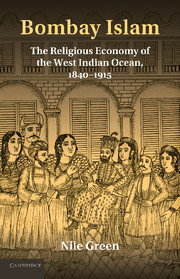Book contents
- Frontmatter
- Contents
- Illustrations
- Acknowledgements
- Maps
- Introduction
- 1 Missionaries and Reformists in the Market of Islams
- 2 Cosmopolitan Cults and the Economy of Miracles
- 3 The Enchantment of Industrial Communications
- 4 Exports for an Iranian Marketplace
- 5 The Making of a Neo-Ismā‘īlism
- 6 A Theology for the Mills and Dockyards
- 7 Bombay Islam in the Ocean's Southern City
- Conclusions
- Notes
- Bibliography
- Index
2 - Cosmopolitan Cults and the Economy of Miracles
Published online by Cambridge University Press: 03 May 2011
- Frontmatter
- Contents
- Illustrations
- Acknowledgements
- Maps
- Introduction
- 1 Missionaries and Reformists in the Market of Islams
- 2 Cosmopolitan Cults and the Economy of Miracles
- 3 The Enchantment of Industrial Communications
- 4 Exports for an Iranian Marketplace
- 5 The Making of a Neo-Ismā‘īlism
- 6 A Theology for the Mills and Dockyards
- 7 Bombay Islam in the Ocean's Southern City
- Conclusions
- Notes
- Bibliography
- Index
Summary
SHRINES FOR A MIGRANT WORKFORCE
The self-conscious modernism that was symbolized by the hybrid Anglo-Oriental architecture of the Anjuman-e Islām School ultimately played a limited role Bombay's religious economy. For the members of the labouring classes who made up the majority of the city's Muslims the appeal of a scientific and scriptural Islam was limited, and their own patterns of religious consumption were as distinct as they were widespread. For many of these labourers from rural and small town backgrounds, the growing number of shrines that emerged in Bombay as the nineteenth century progressed offered the chance to reconnect with the secure roots of custom and so enter a more reassuring cityscape enchanted with the powers holy men made available at their gravesides. This chapter traces the role played in the increasing religious productivity of Bombay by migration from the city's continental hinterlands in Gujarat and the Konkan, whence most of its Muslim labour force originated. On the trail of these demographic shifts, ‘franchises’ of older inland pilgrimage centres in Gujarat and the Konkan were established in Bombay, some of which were especially associated with particular ethnic groups such as Afro-Indian Sīdīs, others with specific activities that typified the city's new way of life, such as the specialist ‘traveller shrines’ beside the sea and railways. As Rodney Stark has observed, ‘To the degree to which a religious economy is pluralistic, firms will specialize.’
- Type
- Chapter
- Information
- Bombay IslamThe Religious Economy of the West Indian Ocean, 1840–1915, pp. 49 - 89Publisher: Cambridge University PressPrint publication year: 2011



